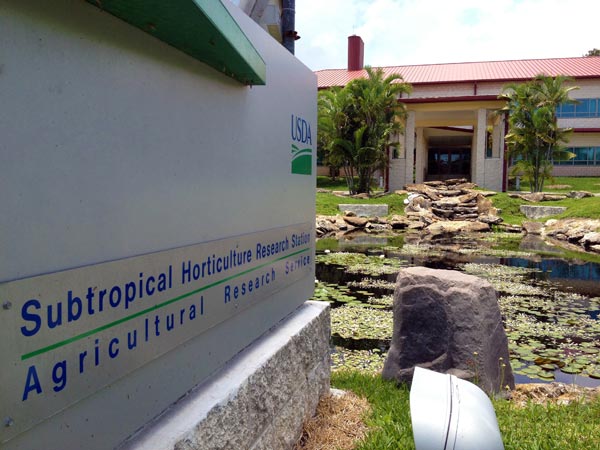Chapman Field ARS Research Center
/Driving down Old Cutler Road at SW 136th Street, you naturally ask yourself “What’s going on behind those fences?” The answer is agricultural research for the U.S. Government.
The 208-acre facility was born out of Dr. David Fairchild’s efforts. In 1923, as a USDA employee, he moved the Plant Introduction Garden from Brickell Avenue to the newly decommissioned Chapman Air Field.
Germoplasm Collection in the fields
While many would equate the Subtropical Horticulture Research Station’s work to watching paint dry, the eight full-time scientists and 25 support staffers beg to differ. I met 13-year Agricultural Research Service veteran Dr. Alan Meerow for an eye-opening tour. He explained how Chapman Field’s research has, and will continue to have, global impact.
Alan W. Meerow, Ph.D., Research Geneticist & Systematist peers through robotic liquid handler
“We are here for preservation, research, development and entomology,” states Meerow. “I am developing ornamentals plants, but we all cross over and help each other.”
Fiji Dwarf Coconut Trees
The facility is home to thousands of seeds and plants. Unlike dozens of other USDA ARS centers around the country, Chapman Field has tropical and sub-tropical field plantings, which makes it one of the more unique facilities. In fact, only Hilo, Hawaii and Mayaguez, Puerto Rico do the same.
Amaryllis Hybrids
The bulk of the land is used for three main crops: (a) sugar cane and subtropical grasses, (b) avocado trees and (c) an impressive 3000 varietals of mangoes. The focus of each is crop improvement. While less than 20% of the facility hosts ornamental plant research, eight new varieties were designed and brought to market from here.
Promising new tabebuia seedling selection
“The most important issue our facility constantly works on is creating crop variations that will help us avoid disease and infestation, said Dr. Meerow, “The longer we farm a plant, the genetic differences get narrower and narrower. This can lead to weaknesses and vulnerability that can wipe out species. We work on re-introducing stronger, diverse variations of that plant to the farm fields.”
Kathleen Carriaga, Biological Science Technician
In avocado research, there is a huge panic and the Chapman Field facility is designated as a First Responder. A few years ago, Redbay trees (an avocado relative) in Georgia started dying off en mass. As it worked its way south, Chapman Field raced into action to find the source of the die off.
They discovered laurel wilt, a fungus disease that is spread by the Redbay Ambrosia Beetle. “The beetle farms the fungus inside the Avocado tree and, in turn, the tree goes into five-alarm response and ends up killing itself after it turns off its own internal plumbing trying to stop the fungus growth.”
Michael Calonje, FIU Ph.D. Student
For a while, laurel wilt stopped around Ft. Pierce, FL, likely due to the patchy nature of our forest canopy. Unfortunately, our luck ran out in late 2011, as the disease has reached Dade County. Emergency research is ongoing with the international community centering its efforts at Chapman Field.
For you chocoholics out there, the facility receives $500,000/year from the M&M Mars Company to study and improve the cacao plant. At present, there are three significant diseases plaguing worldwide cacao seed production. “With seeds at less than 50% of what they were, production is way down and costs are up,” explained Meerow.
Collecting chocolate tree fruit for study
To address this issue, the research center does DNA Marker-Assisted Breeding for cacao. Those efforts result in stronger, more resistant plants. In the future, they could even allow for better tasting chocolate. In short, it is likely that the Subtropical Horticulture Research Station’s work will improve future chocolate bars.
Dr. Alan Meerow shows off DNA multipiers used in research
DNA markers are gene-level tags that rapidly speed along research. Instead of growing a plant to maturity to test for disease resistance, scientists simply look for the presence of the appropriate genetic marker in very young saplings. This cuts years from studies.
Entomology is an important facet of the facility. By studying pheromones and attractants, scientists at Chapman Field have developed traps and lures. The idea is to lower man-made impact on nature by luring away pests from vulnerable plant life, not by spraying chemicals.
This freezer stores plant material at -80 degrees centigrade
By its nature, the facility steers away from pesticide use and instead works to strengthen a plant’s natural defense mechanisms. “Lowering pesticide use is important because, for example, honeybee colony collapse is the result of a variant of pesticide, not cell towers, as is commonly believed. “The pesticide seems to disorient the bees and they can’t find their way back to the hive to reproduce and support the queen.”
If you want to learn more, you’re in luck. In celebration of the USDA’s 150th Anniversary, the research center will hold an annual open house June 23, 2012 (10am-3pm) filled with activities, including lab and field bus tours. Dr. Alan Meerow welcomes everyone to "the biggest accidental secret that isn't supposed to be a secret."












